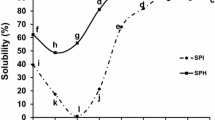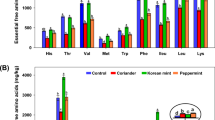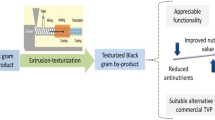Abstract
Hydrolyzed vegetable protein (HVP) has received wide attention as a flavor enhancer that can replace monosodium glutamate (MSG). The objective of this study was to investigate the effect of added acid-hydrolyzed vegetable protein (aHVP) and enzyme-hydrolyzed vegetable protein (eHVP) on consumers’ responses of Korean Doenjang soup. One hundred and twenty female consumers who consume Doenjang soup on a regular basis were participated in consumer test of 8 Doenjang soup samples containing a flavor enhancer such as aHVP, eHVP, or MSG. The results indicated that the HVPs showed flavor-enhancing effects similar to those of MSG, respectively. It was also found that consumers preferred specific aHVP- or eHVP-added samples to MSG-added samples. These findings suggest that HVP could be used as a flavor enhancer in Doenjang products such as Doenjang soup.



Similar content being viewed by others
References
Aaslyng MD, Martens M, Poll L, Nielsen PM, Flyge H, Larsen LM. Chemical and sensory characterization of hydrolyzed vegetable protein, a savory flavoring. J. Agric. Food Chem. 46: 481-489 (1998)
Amsellem S, Ohla K. Perceived odor–taste congruence influences intensity and pleasantness differently. Chem. Senses 41: 677-684 (2016)
Bellisle F, Monneuse MO, Chabert M, Laure-Achagiotis C, Lanteaume MT, Louis-Sylvestre J. Monosodium glutamate as a palatability enhancer in the European diet. Physiol. Behav. 49: 869-874 (1991)
Chrea C, Grandjean D, Delplanque S, Cayeux I, Le Calvé B, Aymard L, Scherer KR. Mapping the semantic space for the subjective experience of emotional responses to odors. Chem. Senses 34: 49-62 (2008)
Chung L, Chung SJ. Understanding the factors affecting the acceptance for fermented soybean products. Food Sci. Biotechnol. 17: 144-150 (2008)
Jinap S, Hajeb P. Glutamate. Its application in food and contribution to health. Appetite 55: 1-10 (2010)
Jo YJ, Cho IH, Song CK, Shin HW, Kim YS. Comparison of fermented soybean paste (Doenjang) prepared by different methods based on profiling of volatile compounds. J. Food Sci. 76: 368-379 (2011)
Jo MN, Lee YM. Analyzing the sensory characteristics and taste-sensor ions of MSG substitutes. J. Food Sci. 73: 191-198 (2008)
Kim HG, Hong JH, Song CK, Shin HW, Kim KO. Sensory characteristics and consumer acceptability of fermented soybean paste (Doenjang). J. Food Sci. 75: S375-S383 (2010)
Kim GE, Kim MH, Choi BD, Kim TS, Lee JH. Flavor compounds of domestic Meju and Doenjang. J. Korean Soc. Food Sci. Nutr. 21: 57-565 (1992)
Kim MK, Lee KG. Correlating consumer perception and consumer acceptability of traditional Doenjang in Korea. J. Food Sci. 79: S2330-S2336 (2014)
Kim MJ, Rhee HS. Studies on the changes of taste compounds during soy paste fermentation. Korean J. Food Cookery Sci. 6: 1-8 (1990)
Kim MJ, Rhee HS. The contents of free amino acids nucleotides and their related compounds in soypaste made from native and improved meju and soypaste product. J. Korean Soc. Food Nutr. 17: 69-72 (1998)
Ko H, Cho D, Hwang S, Kim Y. The effect of quality improvement by Chunkuk-Jang’s processing methods. Korean J. Food Nutr. 12: 1-6 (1999)
Kwak HS, Jung HY, Kim MJ, Kim SS. Differences in consumer perception of Korean traditional soybean paste (Doenjang) between younger and older consumers by blind and informed tests. J. Sens. Stud. 32: e12302 (2017)
Lee SJ, Ahn B. Comparison of volatile components in fermented soybean pastes using simultaneous distillation and extraction (SDE) with sensory characterisation. Food Chem. 114: 600-609 (2009)
Lee SY, Lee S, Lee SM, Oh JY, Jeon EJ, Rye HS, Lee CH. Primary and secondary metabolite profiling of doenjang, a fermented soybean paste during industrial processing. Food Chem. 165: 157-166 (2014)
Manley CH. Process flavors. pp. 139-154. In: Source book of flavors. Reineccius G (ed). Springer US. New York, USA (1994)
Park JS, Lee MY, Kim KS, Lee TS. Volatile flavor components of soybean paste (Doenjang) prepared from different types of strains. Korean J. Food Sci. Technol. 26: 255-260 (1994)
Park SK, Seo KI, Choi SH, Moon JS, Lee YH. Quality assessment of commercial Doenjang prepared by traditional method. J. Korean Soc. Food Sci. Nutr. 9: 211-217 (2000)
Pommer K. New proteolytic enzymes for the production of savory ingredients. Cereal Foods World. 40: 745-748 (1995)
Prescott J. Taste hedonics and the role of umami. Food Aust. 53: 550-554 (2001)
Roh SH, Lee SM, Kim SS, Kim KO. Importance of applying condiments in a commonly consumed food system for understanding the association between familiarity and sensory drivers of liking: A study focused on Doenjang. J. Food. Sci. 83: 464-474 (2018)
Sand J. A short history of MSG. Gastronomica 5: 38-49 (2005)
Shin D, Jeong D. Korean traditional fermented soybean products: Jang. J. Ethnic Foods 2: 2-7 (2015)
Weir GSD. Proteins as a source of flavour. pp 363-395. In: Biochemistry of Food Proteins. Hudson BJF (ed). Elsevier Applied Science Publishers, London, UK (1992)
Acknowledgements
This research was supported by Main Research Program (E0151700-03) of the Korea Research Food Institute (KFRI) funded by the Ministry of Science and ICT, Republic of Korea.
Author information
Authors and Affiliations
Corresponding author
Additional information
Publisher's Note
Springer Nature remains neutral with regard to jurisdictional claims in published maps and institutional affiliations.
Rights and permissions
About this article
Cite this article
Jeon, SY., Lee, YM., Kim, S.S. et al. Effect of added hydrolyzed vegetable proteins on consumers’ response for Doenjang (Korean traditional fermented soybean paste) soup. Food Sci Biotechnol 29, 45–53 (2020). https://doi.org/10.1007/s10068-019-00646-0
Received:
Revised:
Accepted:
Published:
Issue Date:
DOI: https://doi.org/10.1007/s10068-019-00646-0




